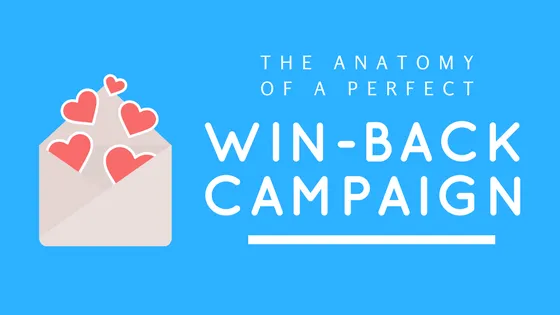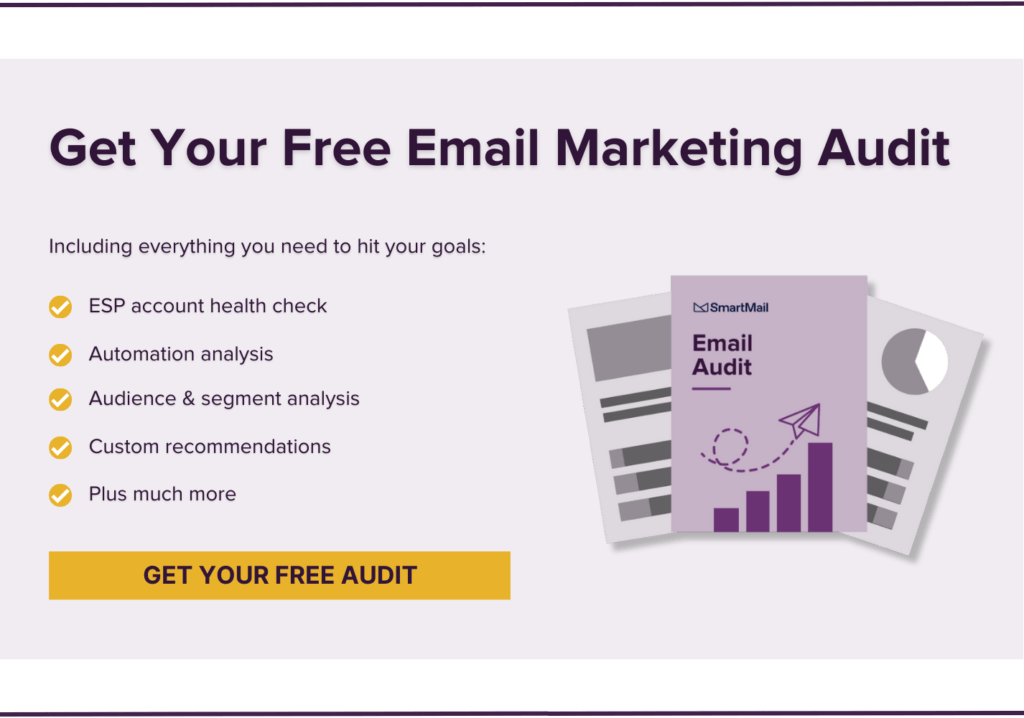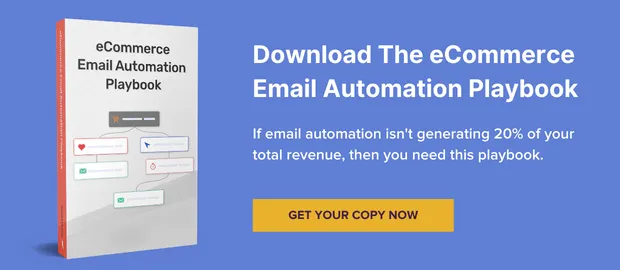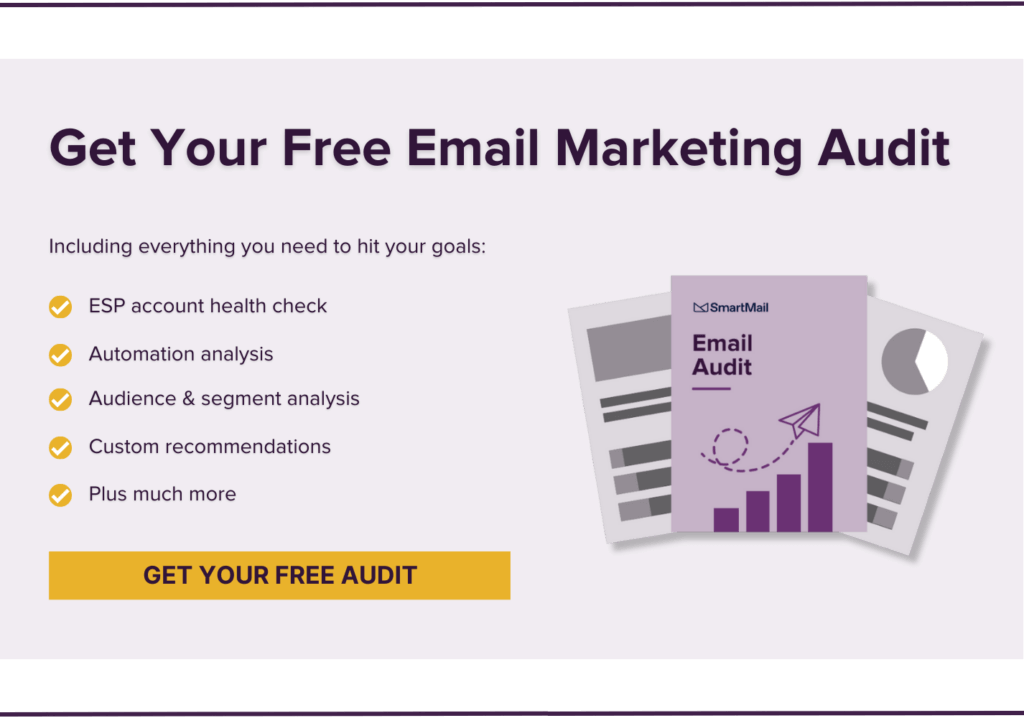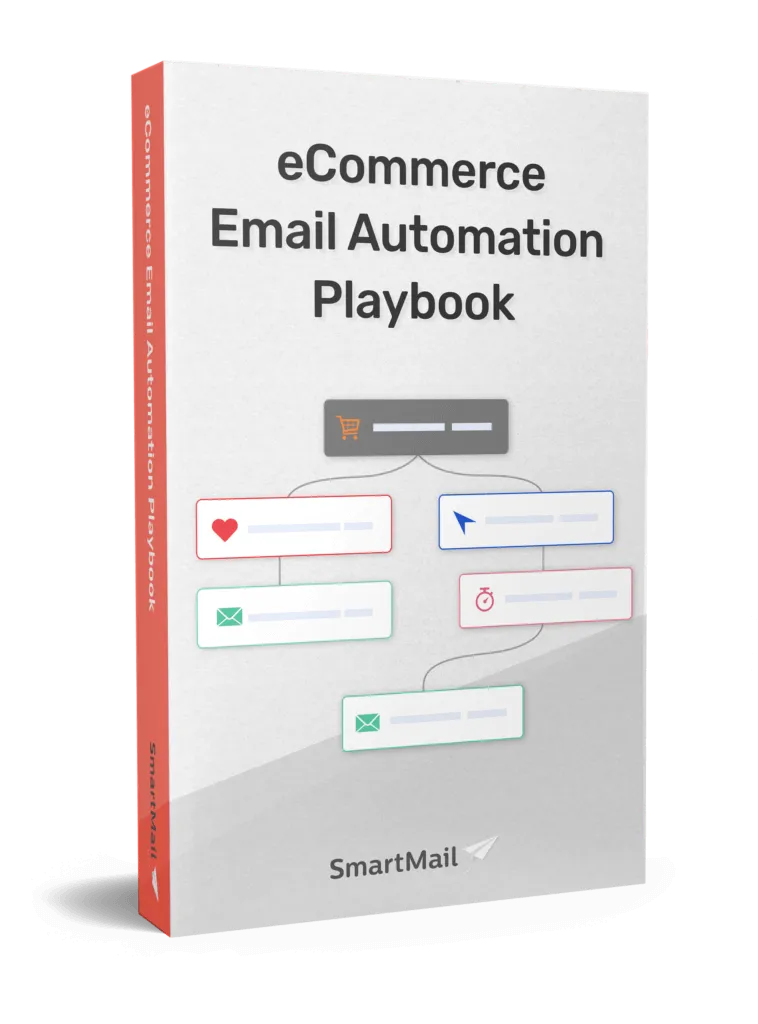Few things in life are as pleasant as being recognized, remembered, and pursued. It appeals to our desire to belong. To be wanted.
And in the eCommerce and digital marketing game, you can do a lot with a little win-back. Customers that have fallen by the wayside aren’t gone forever. A win-back campaign can return them to the fold much faster, easier, and cheaper than acquiring a new customer to replace them.
Six, seven, eight times – or more! – cheaper depending on whom you ask.
Watch How To Craft The Perfect Win Back Email
What Is a Win Back Email?
A win-back email campaign is a series of targeted and personalized messages you send to your lapsed customers. If they’re dormant, they often just need a gentle nudge to wake them up.
And you can do that with the humble win-back email.
But let’s slow down. We have a bit of legwork to do before we start sending anything.
How Profitable are Win Back Campaigns?
Here’s the insider information: triggered emails – those that are sent after an event such as subscribing or purchasing – are the most powerful emails you can send.
People are expecting them. They get opened. They get clicked. They get results. Period.
In fact, triggered post purchase and win back emails get some of the highest open and click-through rates of any email marketing.
But automated win back emails experience an average open rate of 42.51%, a CTR of 18.27% CTR, and a conversion rate (CVR) of 10.34% (source: Remarkety). That’s 2.5x better open and 7.9x better click rates than the industry average.
The customer has just purchased something from you. They are at their most receptive to you and your brand. Take advantage of those warm, fuzzy feelings and reach out. Give thanks.
But don’t stop there. There are plenty of other post purchase email ideas you could slide into your campaigns.
Setting Up Your Win-Back Campaign
The first step is to identify those customers primed for re-engagement. This is not a batch and blast campaign. In order for the strategy to work they must be targeted and personalized.
So, who are the ideal people to target for win back campaigns?
Lapsed and dormant customers. Easy.
What defines a “lapsed” customer? Ah, that’s not so simple. Your definition may be different than mine, and we both may differ from someone else.
The criteria depends heavily on your industry and product. Are you selling a monthly SaaS subscription, beauty products, annual memberships, clothing, fruit baskets, organic pet food, or electronics?
Your product catalog will determine what qualifies as inactive. As a basic rule of thumb, it’s usually around 3-6 months between purchases for eCommerce. But if you sell monthly subscriptions or annual memberships, that’s not going to work for you.
If you sell a 4-week supply of dog food, you’d expect customers to purchase monthly. Annual memberships to your online training seminars? You’d want to see them renew every year.
Step 1: define your buyer cycle. What defines inactive for your business. How often would you expect a “good” customer to buy? What makes a great one?
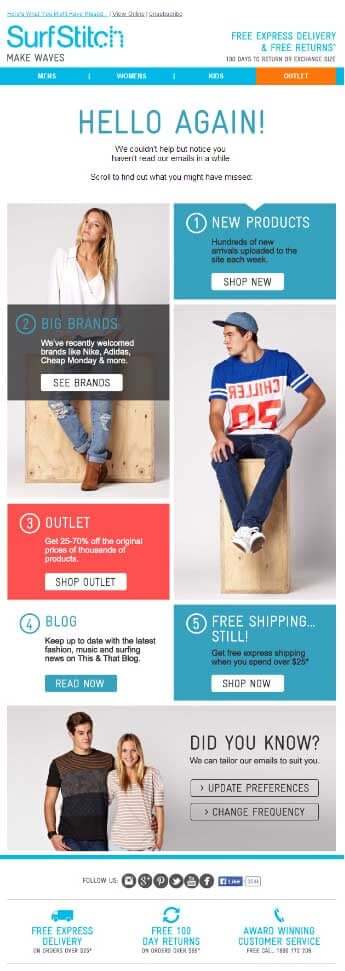
How to Segment Your Win-Back Campaigns
By now, it’s common knowledge that a segmented email list delivers higher open and click-through rates (14.31% and 100.95% higher respectively according to a recent study), and lower unsubscribes and spam complaints.
Once you’ve identified your lapsed customers, you next need to segment that list so you can send the right re-engagement email to the right dormant customer. It’s not one size fits all.
One relatively easy approach to get you going is the RFM Matrix.
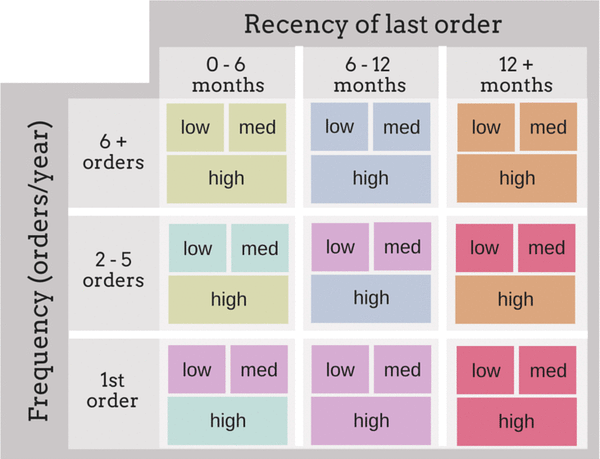
Using just your sales and customer records, you examine each customer in regards to:
- Recency – time in months since their last order
- Frequency – number of orders in the past year
- Monetary Value – average order value (low/medium/high)
You can easily segment based on where they fall in the matrix:
- Those in the green and teal are a-ok. No need to re-engage with them for now.
- Those in purple are lapsing or in danger of lapsing. They’re not there, but it’s probably a good idea to reach out and connect with them.
- Those in light blue are your lapsing best customers, or heroes, or big fish, or whatever else you want to call them (high average value and/or frequency). Do not let them slip away. Re-engage. Win them back.
- Those in orange are your lapsed best customers. Because of their very high value, it’s worth re-engaging at least one more time, perhaps with a last-ditch and impossible-to-resist offer to come back. Go big or go home.
- Those in red are most likely gone and not worth the effort.
Your matrix might look different depending on your typical buyer cycle, but you get the idea.
You can segment by virtually anything providing you have the data. Find a shared quality or characteristic to create a segment, and then go after it with a targeted win-back email campaign.
Step 2: segment your inactive customers email list.
What Types of Win-Back Campaigns Are There?
So, you’ve got a few different segments to work with, and you’re ready to craft a few re-engagement emails. But what should you send?
- The lapsing masses (purple).
- The lapsing heroes (light blue)
- The lapsed heroes (orange)
The types of win-back email is important here. With these three segments, it would make sense to try:
- The Incentive Email. Lapsing masses respond well to an incentive to return and buy again. A coupon, a discount, a promo, a free gift. They’re not yet loyal to you.
- The Hi There! Email. Lapsing heroes might only need a uncomplicated “We miss you!” re-engagement email. Savvy modern consumers want to feel recognized and appreciated.
- The Last Try Email. Lapsed heroes may have lapsed for a wide variety of reasons. But they’ve been loyal and valuable in the past, so try and win them back with a last-ditch whopper of an incentive. Make it bigger and better than the standard 10-15% deal you might otherwise offer.
Of course, they are other types.
Feedback emails simply ask lapsed customers why they’ve moved on. At best, it might be enough to get them back because you’re making the effort with them. At worse, you’ll collect invaluable feedback on ways you can improve your brand, your products, and your customer experience.
Opt-out emails ask lapsed customers to actively chose to remain on your radar (i.e. your email list) or unsubscribe. If they leave, you move on. If they stay, you try again a little later with a different lifecycle or win-back campaign.
Step 3: Select the most appropriate type of win-back email for each segment.
Why Bother with Win-Back Campaigns?
A retained customer is better than an acquired customer in virtually every metric, and a win-back email campaign is one of the easiest ways to increase retention and reduce churn.
- Average email list loses 20-25% of active contacts each year (Hubspot)
- After receiving a re-engagement email, 45% will read subsequent emails (Email Monks)
- About 40% of your revenue comes from repeat customers (Adobe)
- Repeat customers (2+ purchases) have a 60-70% chance of buying again (MarketWired) vs an average of 1-3% for converting a new customer
- Repeat customers are 9x more likely to convert than a new prospect (Adobe)
- Top 10% of your customers spend 3x more than the bottom 90%, while the top 1% spends 5x more (RJMetrics)
Win-Back Campaign Tips and Best Practices
Email marketing is as much art as science, so follow the proven best practices and advice from those already succeeding:
- Keep both subject lines and email templates short and precise
- Have one and only one simple call-to-action
- Send more than one re-engagement email, but throttle their delivery based on time or behavior
- Test different incentives. Marketing Land found that “save X dollars” performed twice as well as “X% off” discounts
- Stay faithful to your brand voice, but don’t be afraid to experiment with your email tone. Be friendly and playful.
- Use whatever existing data you have to personalize your messages
- Remind them of your value and past relationship
Win-Back Campaign Subject Lines
It’s been a while
[First Name], We Want You Back
We Miss You [First Name]
Where Have You Been [First Name]?
Come back to [Company Name]!
Did you forget about your [Company Name] account?
When to Send Your Win-Back Campaign to Shoppers
For this sort of email campaign, there is no one size fits all answer when it comes to the timing of your messages. Examine the sales cycle of your products, and reach back out to dormant shoppers when it makes sense. You can also use site updates and, of course, special promotions as an ice breaker.
Win-Back Campaign Examples
Win-Back Campaign Example #1
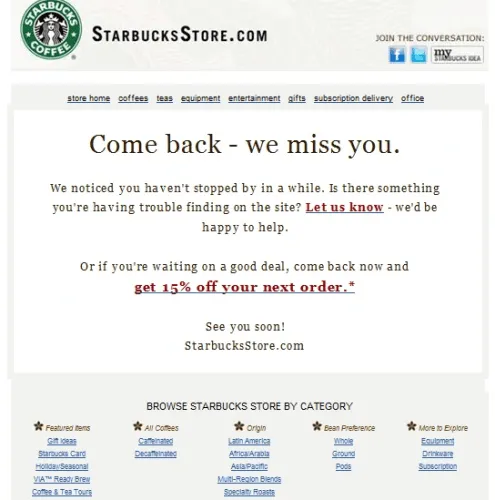
Win-Back Campaign Inspiration: Simple, straight to the point. We miss you, here’s a discount. Who wouldn’t want 15% off their coffee purchase?
Win-Back Campaign Example #2
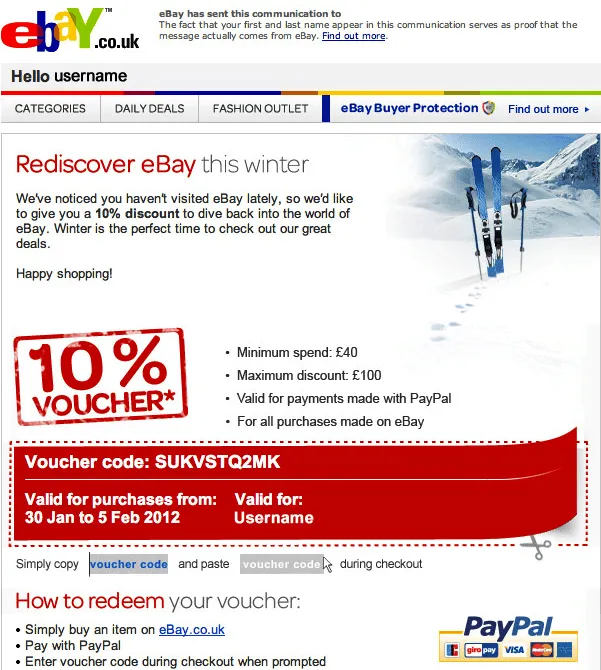
Win-Back Campaign Inspiration: Another win-back campaign using a discount to re-engage with past customers. eBay does a great job of making it easy for customers to claim their discount by including detailed instructions for checkout (although it may seem obvious…).
Customers have a lifecycle. New, repeat, loyal, lapsing, lapsed, gone…
Send the right lifecycle email at the right time, and you can delay the end of that cycle for a lot longer, if not indefinitely.
Are you ready? Let SmartMail help with your first – or next – win-back campaign.
